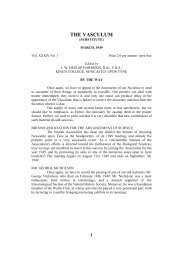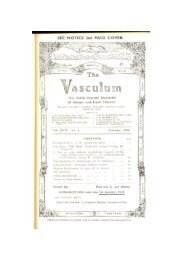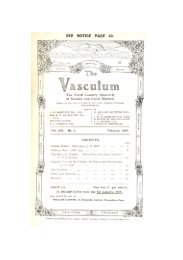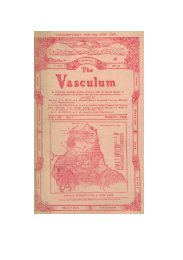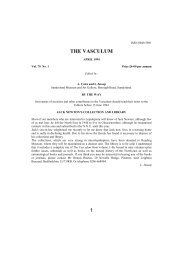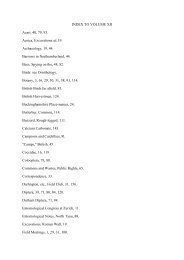1972 - The Vasculum
1972 - The Vasculum
1972 - The Vasculum
You also want an ePaper? Increase the reach of your titles
YUMPU automatically turns print PDFs into web optimized ePapers that Google loves.
35<br />
VASCULUM VOL. LVII. No. 3. <strong>1972</strong><br />
have been represented in the occasional unshaded reaches of the chalk streams of south-east England, where now<br />
it is almost certainly absent. Whether or not this was so its present distribution in Britain is decidedly restricted,<br />
and the streams in Upper Teesdale still form one of the best examples of its development. Although the algae<br />
cannot claim the glamour or quite the rarity of flowering plants like Gentiana verna. It is nevertheless hoped that<br />
the remaining streams will be preserved for all time in something like their present form. While the aIgal<br />
vegetation is unlikely to suffer much from collecting, trampling or any small climatic changes associated with the<br />
reservoir, it might well suffer greatly from any change in land usage, such as any addition of fertilizers.<br />
ACKNOWLEDGMENTS<br />
<strong>The</strong> authors are most. grateful to. the following for helpful discussion: Dr. S. Golubic, Dr. E. Kann, Miss S. M.<br />
Kirkby, Mr. T. Buffey. M.K.H. was supported by a grant allocated by the Teesdale Trust and financed by Imperial<br />
Chemical Industries Ltd.<br />
REFERENCES<br />
Bradshaw, M. E. B., and Clark, W. A. (1965): 1 Flora and vegetation. In: Valentine, D. H. (Ed.) <strong>The</strong> Natural<br />
History of Upper Teesdale, Pp, 23-42. Northumberland & Durham Naturalists' Trust Limited. 70pp.<br />
Geitler, L. (1932): Cyanophyceae. L. Rabenhorst's Kryptogamen Flora XIV. Leipzig.<br />
Holdgate, M. W. (1955): <strong>The</strong> vegetation of some springs and wet flushes on Tarn Moor, near Orton,<br />
Westmorland. J. Ecol. 43; 80-89.<br />
Holmes, T. N. H., Lloyd, E. J. H. Potts, M., and Whitton, B. A. (<strong>1972</strong>): Plants of the River Tyne. <strong>The</strong> <strong>Vasculum</strong><br />
Vol. LVlI: 56-78.<br />
Johnson, G. A. L., Robinson, D., and Hornung, M. (1971): Unique bedrock and soils associated with the Teesdale<br />
flora. Nature, Lond. 232: 453-456.<br />
Pigott, C. D. (1956): <strong>The</strong> vegetation of Upper Teesdale in the North Pennines. J. Ecol. 44; 545-586.<br />
Whitton, B. A. (1970): Toxicity of heavy metals of freshwater algae: A review. Phykos 9: 116-125.<br />
THE DIATOMS OF SLAPESTONE SIKE, UPPER TEESDALE.<br />
J. R. CARTER<br />
Elm Bank, Denholm, Hawick<br />
<strong>The</strong> diatoms examined in this contribution were all collected by Mr. A. Peabody and Dr. B. A.<br />
Whitton, one collection being made on 19th April, 1970 and the other on 6th August, 1970. A complete analysis<br />
has shown little if any significant distinction between the two gatherings, the species present being identical in the<br />
main stream and any rather unusual forms being confined to small tributaries and flushes<br />
<strong>The</strong> samples contain 108 identified species, and two or three which are either quite new or perhaps<br />
inadequately described in the literature. <strong>The</strong>se latter forms have, of necessity been omitted from discussion here<br />
and will receive attention later. Taken from between forty and fifty stations from the headwaters of the Cow Green<br />
reservoir, all kinds of habitats have been sampled and the results show some containing as many as 50 different<br />
forms whilst one, a peaty drain, was completely devoid of diatoms. As one would expect the richest hauls came<br />
from amongst mosses, Rivularia colonies, algal beds and from some of the adjacent vegetation like liverworts. All<br />
these dwellers in the stream tend to act as filters to catch the diatoms and one cannot be sure that to find a form in<br />
such



